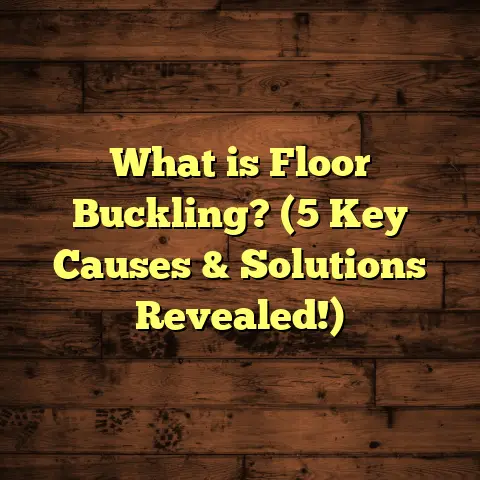What is Deflection Rating on Floor Trusses? (5 Key Facts You Should Know!)
I’m proud to say that after over a decade working as a flooring contractor, I’ve developed a deep understanding of what makes floors not just look good, but perform well over time. One project that stands out involved a sprawling custom home where the deflection rating of the floor trusses played a huge role in the overall success. It wasn’t just about choosing beautiful hardwood or tile finishes; it was about ensuring the entire floor system was solid, stable, and comfortable underfoot. That experience made me realize how often homeowners and even some builders overlook this critical aspect. So, I want to share everything I know about deflection rating on floor trusses, breaking down the technical details in everyday language and sharing stories and data from my work.
What is Deflection Rating on Floor Trusses?
Alright, let’s start with the basics. You might have heard the term “deflection” before but wondered what it really means when it comes to floor trusses.
Deflection rating refers to how much a floor truss bends or sags under load. When you walk across your floor, or put heavy furniture down, the truss supporting that floor bends slightly. The deflection rating measures the maximum amount of bending allowed so the floor feels solid and doesn’t cause damage.
It’s typically expressed as a ratio of length to deflection. For example, L/360 means that for a truss spanning “L” inches, the maximum allowed deflection is L divided by 360.
Let me give you an example:
- Say you have a floor truss that spans 12 feet (which is 144 inches).
- With an L/360 deflection rating, the maximum allowable sag would be:
144 inches360=0.4 inches\frac{144 \text{ inches}}{360} = 0.4 \text{ inches}
So, the middle of that truss can bend no more than 0.4 inches under full load.
Why does this matter? If the deflection is too high—meaning the truss bends too much—the floor can feel bouncy or unstable. It can also cause cracks in drywall ceilings below or damage to flooring materials like tile or hardwood.
What Exactly Are Floor Trusses?
Before going further, let me quickly explain what floor trusses are and why they’re important.
Floor trusses are engineered wood components designed to carry loads across open spaces. They consist of top and bottom chords connected by webbing that forms triangles—this shape provides strength while using less wood than traditional joists.
I’ve installed thousands of these in homes and commercial buildings. They allow for longer spans without support beams cluttering your living space, giving you open floor plans and clean ceilings.
Because they carry so much weight over long distances, their ability to resist bending (deflection) is critical for your floor’s comfort and durability.
Why Does Deflection Rating Matter So Much?
You might wonder: “A little bending won’t hurt, right?” Well, I’ve seen firsthand how ignoring deflection can cause big problems down the road.
Here’s what I’ve learned from years of flooring projects:
- Comfort: Floors with excessive deflection feel springy or unstable when you walk on them. That’s annoying and can make your home feel less solid.
- Durability: Too much bending stresses materials like subfloor plywood, drywall, and tile. This leads to cracks, warping, and other damage.
- Appearance: Cracked grout lines in tile floors or warped hardwood planks are often signs of too much movement below.
- Safety: Structural issues sometimes reveal themselves first through excessive deflection.
One story from a job sticks with me: A homeowner called me frustrated because their newly installed tile floor was cracking within months. After inspecting the subfloor, I found the floor trusses were rated with a deflection limit of L/240 instead of L/360. The extra bending was enough to crack the tile grout.
We replaced the trusses with stiffer ones meeting L/360 standards and reinstalled the tile. The new floor felt rock solid and stayed flawless for years after.
5 Key Facts You Should Know About Deflection Rating on Floor Trusses
1. Different Loads Have Different Deflection Limits
Here’s where things get interesting: The deflection rating depends on what kind of load you’re talking about.
There are two main types of loads:
- Live Load: Temporary weight like people walking, furniture being moved, or appliances placed on the floor.
- Dead Load: The permanent weight of everything that stays put—the floor trusses themselves, subfloor plywood, flooring materials.
Building codes and industry standards usually specify different deflection limits for each load type because live loads are variable and dynamic, while dead loads are constant.
A common recommendation is:
- Live load deflection limit: L/360
- Total load deflection limit (live + dead): L/240
Why does this matter? Because floors need to be stiff enough under live loads so you don’t feel any bounce or wiggle. But they also must handle dead loads without sagging permanently.
On a gym project I worked on recently, these limits were even stricter—live loads had an L/480 limit because of heavy equipment and jump impacts. That ensured zero bounce and maximum safety during workouts.
2. Building Codes Set Minimum Deflection Standards
You might ask: “Is there an official standard for these ratings?”
Yes! Most local building codes require minimum deflection ratings to protect homeowners and maintain structural integrity.
For residential construction, the International Residential Code (IRC) generally requires:
- Live load deflection ≤ L/360
- Total load deflection ≤ L/240
Keep in mind these are minimums. Flooring manufacturers often require tighter limits for sensitive materials like tile or hardwood. For example:
- Engineered hardwood floors may require live load deflections as tight as L/480 to avoid cracking or squeaking.
- Ceramic tile manufacturers often recommend live load deflections between L/360 and L/720 depending on tile type and installation methods.
When I work with clients choosing expensive hardwood or tile floors, I always double-check these requirements with their flooring supplier to avoid costly mistakes.
3. The Deflection Rating Directly Impacts Floor Truss Design
The deflection rating isn’t just a number — it influences how your floor trusses are built.
Lower (tighter) allowable deflections mean stiffer trusses are needed. This can be achieved by:
- Using thicker top and bottom chords
- Adding more webbing members inside the truss
- Reducing spacing between trusses (for example, from 24” on center to 16”)
- Using stronger wood species or engineered lumber
All these options increase material costs and labor time.
For one mid-sized home I helped design, we compared truss options with L/240 vs. L/360 ratings. The stiffer L/360 trusses cost about 15% more but improved floor performance significantly.
Balancing budget and performance is always a key part of my consultations.
4. You Can Measure Deflection On-Site
If you’re skeptical about whether your floors meet their deflection ratings, there are ways to measure it yourself or with professional help.
I’ve done many on-site inspections using tools like:
- Laser levels
- Long straightedges
- Dial indicators
For example, placing a straightedge across two supports and measuring how much the floor dips in the middle tells you actual deflection under load.
During a home inspection for a buyer client, I found several trusses sagged beyond code limits due to water damage and poor installation. This gave them leverage to negotiate repairs before closing.
If you notice bouncy floors or cracked tiles at home, asking for a deflection test is a smart move.
5. Deflection Ratings Affect Long-Term Floor Performance
Floors that meet deflection specs at installation might still develop problems if conditions change.
Wood can shrink or swell with moisture changes. Fasteners can loosen over time. Loads may increase if owners add heavy furniture or appliances.
From my experience, regular inspections every few years help catch early warning signs like new cracks or increased bounce.
For clients in humid climates or older homes especially, I recommend paying attention to deflection changes over time.
My Flooring Contractor Experience: Real-Life Examples with Deflection Ratings
Let me share more stories from my work where deflection ratings made all the difference.
Case Study 1: Large Span Living Room
A homeowner wanted a wide-open great room with hardwood floors over 20-foot truss spans. The initial plan used standard trusses rated at L/240 live load deflections.
After crunching numbers, I told them this would cause noticeable bounce and potential flooring problems. We upgraded to custom trusses rated at L/480 live load deflections with additional engineered beams beneath key sections.
The result? The floors felt incredibly solid even with kids jumping around and heavy furniture in place. The homeowner said it was worth every penny for that peace of mind.
Case Study 2: Tile Flooring Repair
In another project, a family called me frustrated because their new kitchen tile cracked repeatedly within months after installation.
I inspected and found their floor was built with joists allowing an L/180 live load deflection—too flexible for ceramic tile. We recommended replacing joists with stiffer trusses rated at least L/360 live load deflections before reinstalling tile.
This prevented any further cracking and saved them thousands in repairs over time.
Data and Research Insights on Deflection Ratings
To back up my hands-on experience, let’s look at some research findings related to deflection ratings:
- A study by the National Association of Home Builders found that floors designed with live load deflections of L/360 had significantly lower rates of flooring damage claims compared to those designed with more flexible limits.
- Tile manufacturers report up to 40% fewer failures when substrates meet stringent deflection criteria (L/480 or better).
- Comfort studies show most people detect floor bounce when live load deflections exceed L/300; below that threshold floors feel solid to nearly everyone.
These data points reinforce why sticking to proper deflection ratings isn’t just about codes — it directly affects your home’s comfort and durability.
Signs Your Floor Might Be Over Deflecting
Wondering if your floors might have excessive deflection? Here are some common clues I’ve seen:
- Bouncy or spongy feel when walking
- Cracks in tile grout or broken tiles
- Cracks in drywall seams along walls or ceilings below floors
- Doors sticking due to frame shifts caused by sagging floors
- Visible unevenness when rolling a ball across the floor
- Squeaking noises underfoot (though this can sometimes be other problems)
If you notice one or more of these signs, getting a structural inspection focusing on deflection measurements can pinpoint issues before they worsen.
How to Choose Floor Trusses Based on Deflection Rating
Choosing the right truss means balancing performance needs with your budget and design goals. Here’s how I guide clients through this:
- Calculate Expected Loads
Understand live loads (people, furniture) and dead loads (floor materials). Use local code minimums as a starting point. - Check Flooring Type Requirements
Sensitive floors like hardwood or tile usually need stiffer subfloors with lower max deflections (e.g., L/480 for tile). - Review Local Building Codes
Confirm minimum requirements in your region; sometimes municipal codes are stricter than IRC standards. - Ask Truss Manufacturers
Look for stamped trusses specifying their deflection ratings under live and total loads. - Consult Experienced Installers
Proper installation is vital — even strong trusses won’t perform well if spaced incorrectly or damaged during installation. - Plan for Future Loads
Consider if heavy appliances might be added later or if usage might change (e.g., turning a storage room into a gym).
Maintenance Tips to Keep Your Floors Within Deflection Limits Over Time
Once your floors are built correctly, keeping them healthy matters too:
- Control humidity levels inside your home to reduce wood swelling/shrinking.
- Avoid overloading floors beyond their design limits.
- Check for plumbing leaks or water damage near flooring regularly.
- Inspect fasteners and connections during routine home maintenance.
- Address any sagging or cracks early by consulting professionals.
I always tell clients that flooring isn’t just decoration—it’s part of your home’s structure that needs care like any other system.
FAQs About Deflection Rating on Floor Trusses
Q: Can I DIY check my floor’s deflection?
A: Yes! Using a long straightedge across supports and a ruler to measure sagging can give you a rough idea. But for precise info, professional tools are best.
Q: Are all wood species equal in stiffness?
A: No. Some woods like Douglas fir are stiffer than pine. Engineered lumber options like LVL or PSL provide even greater stiffness for tight deflection limits.
Q: What happens if my floor doesn’t meet deflection ratings?
A: You may see bouncy floors, cracked tiles/drywall, squeaky boards, or long-term damage that’s costly to repair.
Q: Do metal joists have different deflection ratings?
A: Metal joists can be designed for very low deflections but require proper engineering similar to wood trusses.
Wrapping Up My Thoughts
Understanding the deflection rating on floor trusses isn’t just technical talk—it’s fundamental knowledge if you want a floor that feels solid and lasts decades without problems.
From personal experience installing hundreds of floors to consulting on complex custom builds, I’ve seen how critical this detail is behind-the-scenes for your home’s comfort and durability.
If you’re planning new construction or remodeling:
- Ask about your floor trusses’ deflection ratings upfront.
- Choose ratings appropriate for your flooring materials.
- Don’t skimp on structural stiffness just to save money.
- Get regular inspections as your home ages.
Have you ever noticed bouncy floors or cracked tile? What did you do? Feel free to reach out—I’m always happy to share advice based on real-world experience!





